Test Breakdown & Sample Questions
In Raven’s APM you’ll face several core matrix-puzzle types—each honing a different facet of your fluid-reasoning “prep”:
- Single-rule progression
One consistent transformation (e.g. adding a line or dot) applies across rows and columns. You’ll need sharp pattern-spotting and focused attention to track that one rule. - Dual-rule separation
Different parts of the figure (shape vs. shading, for example) follow independent rules along rows and columns. Success here demands strong working-memory and the ability to juggle two sequences at once. - Construction/overlay
The correct choice is literally the “sum” of two preceding cells combined. This tests your skill at integrating multiple visual elements in a single leap of insight. - Exclusive-OR (XOR) logic
Only the features unique to the first two cells survive into the third. You’ll need nimble logical reasoning to exclude shared traits and zero in on what’s left. - Rotation/reflection
Shapes may rotate or flip systematically. Excel here by mentally manipulating figures—imagining turns, flips, and mirror-images on the fly.
Mastering each type—and practicing them in realistic time-pressured drills—builds the precise suite of skills Raven’s test measures: rapid concept acquisition, abstract pattern recognition, visual working-memory, and agile problem-solving.
Here’s a concise overview of the main Raven’s APM question types, what each assesses, and the core skills you’ll need to master them:
| Question Type | What it Assesses | Required Skills |
|---|---|---|
| 1. Single-rule progression | One consistent transformation across rows/columns | Focused pattern-spotting and sustained attention |
| 2. Dual-rule separation | Two independent rules (e.g. shape vs. shading) | Strong working memory and ability to juggle multiple rules |
| 3. Construction/Overlay | Combining two cells into one “summed” solution | Integrative thinking and visual synthesis |
| 4. Exclusive-OR (XOR) logic | Features unique to each of two cells | Precise logical reasoning and feature-exclusion |
| 5. Rotation/Reflection | Systematic turns or flips of shapes | Mental manipulation and spatial visualization |
1. Single-Rule Progression Questions
These APM items present a simple, consistent change—such as adding a dot, extending a line, or altering shading—that repeats across each row and column of the 3×3 matrix. Your job is to discover that one rule and apply it to the empty cell.
What It Measures
- Acute pattern-spotting: noticing subtle, regular changes
- Sustained attention: tracking the same rule through multiple cells
- Speed of concept acquisition: grasping the transformation quickly under time pressure
Detailed Strategies
- Scan systematically
- Look at the first row left-to-right: identify what changes from cell 1 → cell 2 → cell 3.
- Confirm in the second row that the same change recurs from its first two cells.
- Characterize the rule
- Is it an additive change (e.g. one extra line, dot, or shape)?
- A subtractive change (e.g. removing a feature)?
- A quantitative shift (increasing number of items)?
- A qualitative tweak (line thickness, shape orientation)?
- Predict and verify
- Mentally apply the rule to the third cell in each row to see if it matches an answer choice.
- Double-check consistency down columns as well—every row and column should obey exactly the same transformation.
- Use elimination
- Quickly cross out options that break the pattern in any row or column—this often leaves one clear choice.
Step-by-Step Approach on Test Day
- First 5 seconds: Recognize you’re in a single-rule item—ignore multi-rule distractors.
- Next 15 seconds: Pinpoint the exact change (shape, count, orientation, shading).
- Following 30 seconds: Scan answer set; mentally “apply” the rule to each candidate.
- Final 10 seconds: Confirm consistency across both rows and columns, then mark your answer.
Common Pitfalls to Avoid
- Over-complicating: forcing a second rule where only one exists
- Skipping columns: neglecting to verify the rule vertically
- Rushing: marking without full confirmation, leading to careless errors
Practice Recommendations
- Drill 50+ single-rule matrices under timed, 90-second conditions to build speed
- After each practice item, write down the rule in words (“Add one dot clockwise”) to reinforce pattern vocabulary
- Use flash-card apps with auto-generated single-rule APM questions for randomized exposure
Mastering single-rule progression lays a solid foundation for the more complex dual-rule and overlay items you’ll encounter on Raven’s Progressive Matrices. Focus on precision first, then gradually ramp up your pace—this balance is the key to top scores in Raven’s Advanced Progressive Matrices prep.
Sample Single-Rule Progression Question
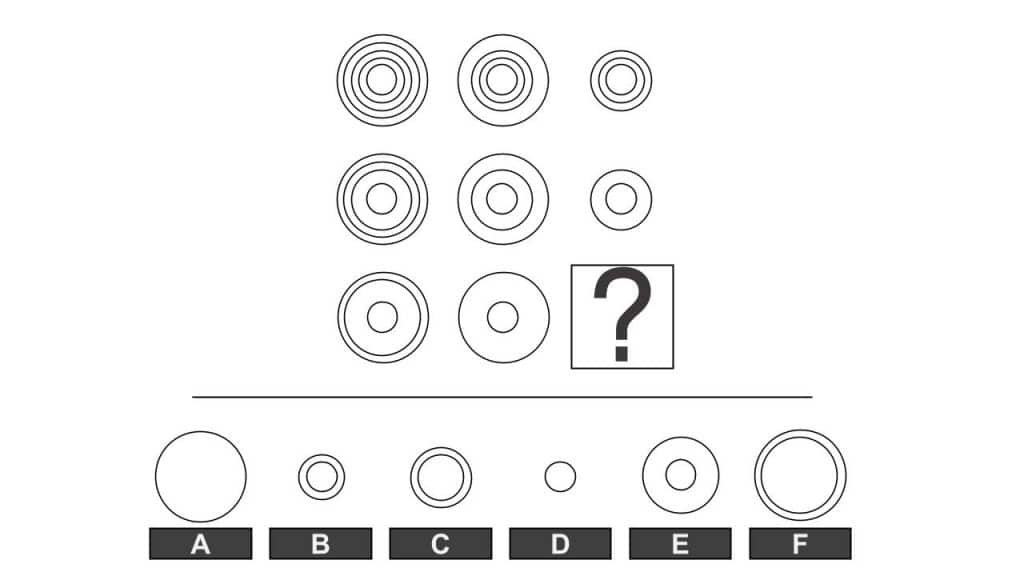
The correct answer is D.
Explanation:
To solve this matrix puzzle, follow the 2×2 Steps logic.
Start with element 1, which has five circles (the “bullseye”).
- Moving one step to the right removes the closest circle to the external circle.
- Moving two steps to the right removes the external circle.
- Moving one step down removes the closest circle to the internal circle.
- Moving two steps down removes the third (middle) circle.
The missing element takes two steps to the right and two steps down, leaving only the internal circle. Option D matches this pattern perfectly.
2. Dual-Rule Separation Questions
In these APM items, two different transformations occur simultaneously—one rule applies to one feature (e.g. shape), and a second rule applies to another (e.g. shading). Your task is to track both in parallel and determine which answer satisfies each rule in every row and column.
What It Measures
- Cognitive flexibility: shifting attention between two patterns
- Working-memory: holding both rules active as you scan
- Divide-and-conquer reasoning: isolating features to prevent rule-mixing
Detailed Strategies
- Identify the two features
- Quickly distinguish which attribute changes (shape, count, shading, position).
- Isolate each rule
- Focus first on Feature A: scan rows to see its consistent progression.
- Then switch to Feature B: do the same for the second attribute.
- Annotate mentally or on scrap
- Label Rule 1 (e.g. “+1 shape”) and Rule 2 (e.g. “flip shading”) to keep them distinct.
- Apply both rules to candidate answers
- Reject any option that violates either transformation in any row or column.
Step-by-Step Approach on Test Day
- First 10 seconds: Spot two changing features—don’t assume a single-rule item.
- Next 20 seconds: Track Rule 1 across rows, then confirm in the columns.
- Following 20 seconds: Track Rule 2 the same way.
- Final 20 seconds: Cross-check each answer choice against both rules, eliminate those that break either, and select the one that fits both.
Common Pitfalls to Avoid
- Rule fusion: accidentally blending the two rules into one complex pattern
- Feature neglect: focusing on the more obvious change and missing the subtler one
- Over-elimination: discarding valid options because they momentarily seem to violate one rule
Practice Recommendations
- Drill 30–40 dual-rule matrices under timed, 120-second conditions to build your mental juggling
- After each practice set, write both rules in shorthand (e.g. “Shape→add, Shade→invert”) to reinforce clarity
- Use mixed-question banks that alternate single- and dual-rule items to sharpen your rule-detection reflexes
Mastering dual-rule separation is a critical step in your Raven’s Progressive Matrices preparation—nail this, and you’ll handle multi-rule APM puzzles with confidence.
Sample Dual-Rule Separation Question
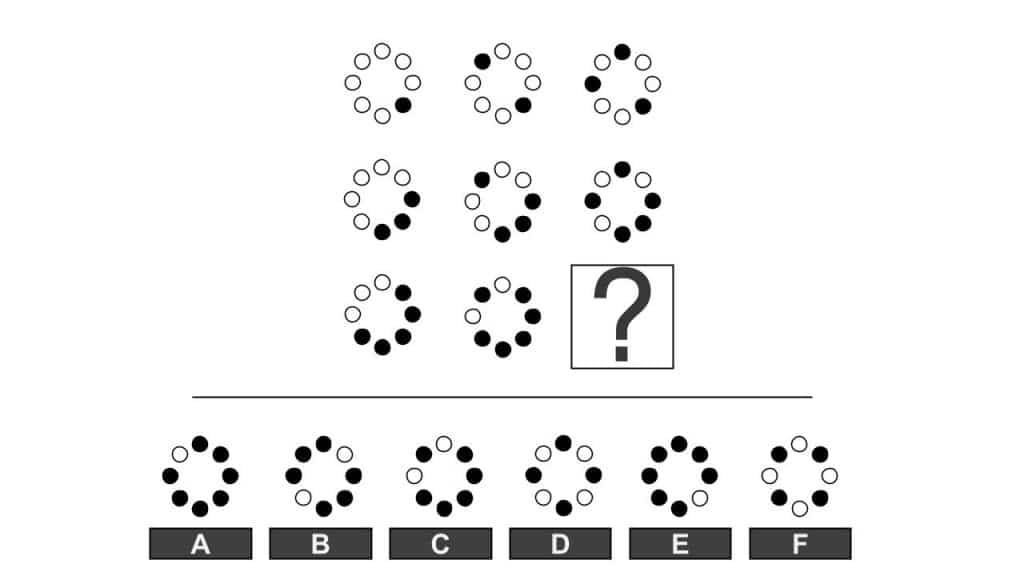
The correct answer is A.
Explanation:
To solve the matrix, follow the 2×2 Steps logic:
Start with Element 1, imagining it as a necklace with eight beads, one of them black.
1 Step to the right: Add another black bead opposite the first black bead. This pattern is seen in the middle column.
2 Steps to the right: Place two black beads on both sides of the bead added in Step 1, then turn the bead placed in Step 1 white. This pattern is seen in the right column.
Step 1 Down: Add two black beads on both sides of the original black bead, replacing white beads. This pattern is seen in the middle row.
Step 2 Down: Add two more black beads on both sides of the three black beads from Step 1, replacing white beads. This pattern is seen in the bottom row.
The missing element must follow both Step 1 & 2 Right and Step 1 & 2 Down. Unlike other elements, it should result in a series of black beads with only one white bead opposite the original black bead. Option A demonstrates this.
3. Construction/Overlay Questions
These APM items ask you to merge—or “overlay”—two given cells to form the missing third cell. Think of it as visually adding cell A and cell B to get cell C: shapes, lines, or shading from both must appear in the blank spot.
What It Measures
- Visual synthesis: combining multiple elements into a coherent whole
- Integrative reasoning: seeing how separate parts interact under one transformation
- Selective attention: distinguishing which features carry over and which don’t
Detailed Strategies
- Determine the pair
- Identify which two of the three cells in a row or column are being combined (often cell 1 + cell 2 → cell 3, but sometimes 1 + 3 → 2).
- Map features
- List out key features in each source cell: count, shape, orientation, shading.
- Overlay mentally or on scrap
- Imagine “stacking” cell A over cell B; note where features overlap versus where they simply coexist.
- Filter answer choices
- Eliminate any option that omits a feature present in either source cell or adds extra, unintended elements.
Step-by-Step Approach on Test Day
- First 10 seconds: Recognize the overlay pattern—two source cells combine.
- Next 20 seconds: Isolate features from each source cell; decide which merge rules apply (e.g. additive vs. overriding).
- Following 25 seconds: Preview answer set, mentally overlay the two source cells for each candidate.
- Final 15 seconds: Confirm the chosen option includes all and only the needed features.
Common Pitfalls to Avoid
- Misidentifying source cells: overlaying the wrong pair
- Overlooking overrides: when one feature should replace rather than simply add (e.g. shading overrides shape)
- Ignoring negative space: forgetting that blank areas may shift or invert
Practice Recommendations
- Drill 20–30 overlay matrices under 90-second time limits to hone your merging speed.
- Sketch quick Venn-diagram–style overlays on scrap paper to reinforce the “sum” concept.
- Alternate overlay drills with single- and dual-rule items to keep your prep balanced and ensure you spot the right pattern immediately.
Sample Construction/Overlay Question
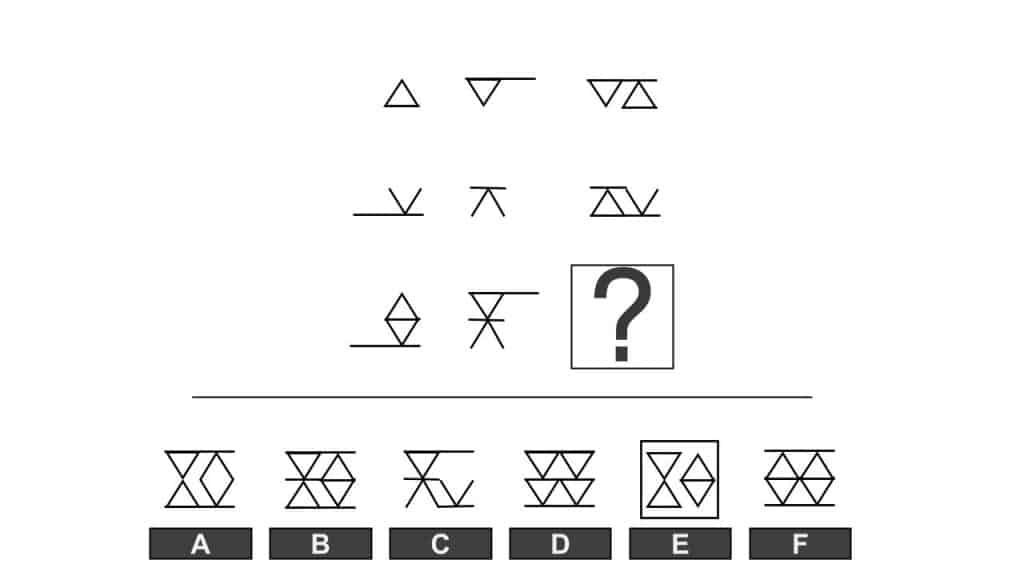
The correct answer is B.
Explanation:
This matrix is a classic “4 building blocks” matrix.
Elements 1, 2, 4, and 5 are the four basic building blocks. Combining the elements of the left and middle columns result in the right column, while combining elements of the top and middle row result in the bottom row.
The missing element is the combination of all four building blocks, or the combination of elements in the right column (3&6) or bottom row (7&8). Either way, you will get the shape in option B.
Tips & Tricks:
Even if you recognize the “four building blocks” structure, try generating the missing element by combining the elements of the right row or the bottom row – it is usually much easier.
4. Exclusive-OR (XOR) Logic Questions
In Raven’s Progressive Matrices XOR items require you to identify features unique to one cell or the other, then carry only those into the missing spot. Here’s how to master them:
What It Measures
- Precise logical reasoning: distinguishing shared vs. unique attributes
- Selective attention: filtering out common features
- Abstract rule application: applying “either-or” logic under time pressure
Detailed Strategies
- Spot the pair
- Determine which two cells (usually the first two in a row or column) you’re comparing.
- List features
- Note every shape, line, or shading in Cell A and Cell B.
- Apply XOR
- Remove any feature that appears in both; only carry forward what’s exclusive to each.
- Check candidates
- Eliminate options that include shared features or omit any unique ones.
Step-by-Step on Test Day
- 0–10 sec: Recognize the XOR pattern—two sources, one result.
- 10–25 sec: Jot in your mind the shared vs. unique features of each source cell.
- 25–40 sec: Run through answer choices, rejecting any that break the XOR rule.
- 40–50 sec: Verify consistency across both the row and the corresponding column before selecting.
Common Pitfalls
- Missing shared elements: accidentally including a feature present in both source cells
- Over-filtering: discarding genuinely unique features as “noise”
- Time squeeze: getting bogged down listing every micro-detail—focus on the most salient attributes first
Practice Recommendations
- Drill 25–30 XOR items under 60-second limits to train speedy feature exclusion
- Use simple sketches or shorthand notes (“A only: ▲; B only: ▣”) to record unique traits
- Combine XOR practice with rotation/reflection drills so you instantly spot which rule applies
Mastering XOR logic in Raven’s Advanced Progressive Matrices prep builds the razor-sharp reasoning you need for the toughest fluid-intelligence puzzles.
Sample Exclusive-OR (XOR) Logic Question
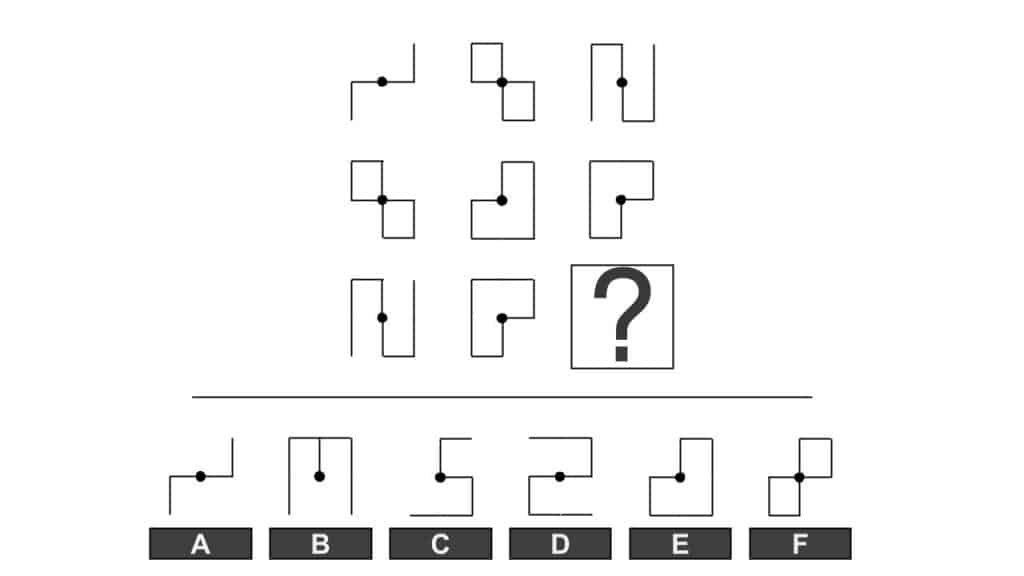
The correct answer is D.
Explanation:
The solution relies on understanding the combined logic of rows and columns.
Compare any two elements within one column or row. If they share a line, the third element in that column/row won’t have that line. Conversely, if a line appears in only one of them, it’s included in the third element.
The only consistent feature across all elements is the small black circle in the middle.
To find the missing element, compare either the left and middle elements of the bottom row or the top and middle elements of the right column. In the image below, the red lines are the shared lines that won’t appear in the missing element. The green lines are unique to each element and will appear in the missing element.

The correct solution is the combination of green lines from both elements, matching option C –

5. Rotation/Reflection Questions
In Raven’s Progressive Matrices rotation/reflection items ask you to spot how shapes turn or flip systematically. You’ll see one or two cells rotate by a set angle or mirror across an axis, then apply that same motion to complete the matrix.
What It Measures
- Spatial visualization: mentally turning figures in your head
- Mental rotation speed: performing that transformation quickly under time pressure
- Attention to orientation cues: distinguishing clockwise vs. counter-clockwise or horizontal vs. vertical flips
Detailed Strategies
- Identify the transformation
- Note if shapes rotate (90°, 180°, etc.) or reflect (mirror-image) between the first two cells.
- Determine direction and increment
- Is it a clockwise turn? A flip along a vertical axis? Confirm the exact angle or mirror line.
- Visualize the application
- Imagine moving the shape step-by-step—pause at half-way points if it helps fix the orientation in your mind.
- Match to answer choices
- Eliminate any option whose orientation deviates even slightly from the predicted rotation/reflection.
Step-by-Step on Test Day
- 0–10 sec: Recognize rotation/reflection pattern—don’t overthink overlay or XOR logic here.
- 10–25 sec: Pin down the exact angle or axis by comparing the first two cells.
- 25–40 sec: Mentally rotate/flip a simple sketch or your eyes through the answer set.
- 40–50 sec: Double-check consistency in the corresponding column before locking in your choice.
Common Pitfalls
- Angle confusion: misreading a 90° turn as 180°
- Mirror-axis mix-up: flipping top-to-bottom instead of left-to-right
- Over-detailing: focusing on minor design quirks instead of the gross orientation change
Practice Recommendations
- Drill 30–40 rotation/reflection puzzles under 60–90 second limits so you nail the motion instantly.
- Use tracing paper or scrap notes to sketch quick outlines and “turn” them physically if you struggle mentally.
- Mix these with other Raven’s Advanced Progressive Matrices question types to sharpen your pattern-type recognition reflex.
Sample Rotation/Reflection Question
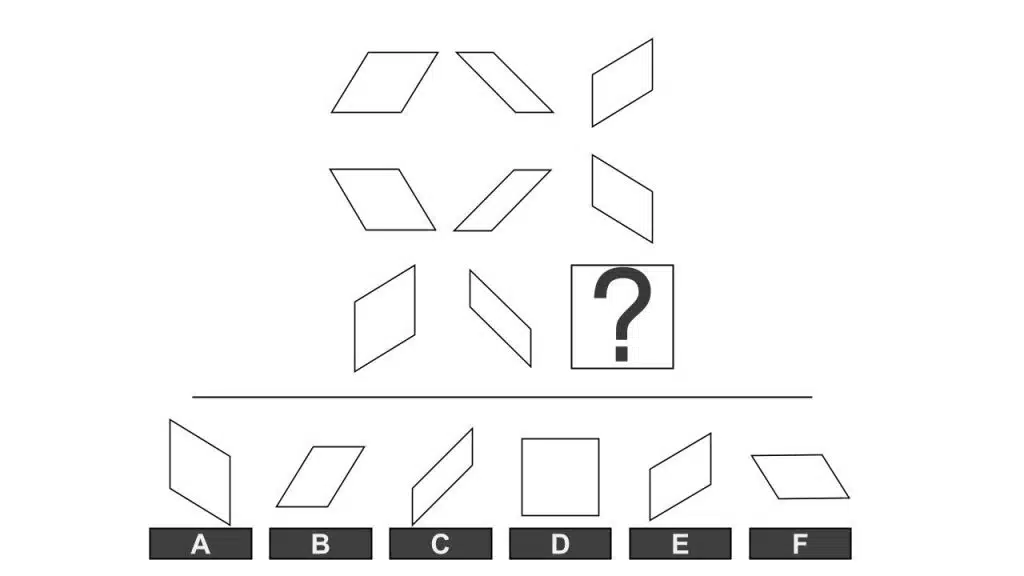
The correct answer is B
Explanation:
To solve this matrix, focus on the logic by columns. Each column has a distinct type of parallelogram. Between the first and second rows, it flips horizontally. Between the second and third rows, the parallelogram rotates 90 degrees clockwise.
Raven’s APM Navigation Pad
Did you know?
Did you know Raven’s APM-III splits into a 12-item easy set and an 11-item hard set, scored as age-adjusted percentiles? Top performers often excel at detecting patterns and learning rules on the fly. Delivered via computer under a 40-minute cap, results help employers predict problem-solving ability and leadership potential against international norms.
Preparation Strategies
Effective preparation for Raven’s Progressive Matrices hinges on deliberate, targeted practice rather than random drills. The strategies below will help you build the precise skills—and the confidence—you need to excel.
- Establish your baseline
Begin with a timed diagnostic of 20–30 mixed–type matrices. This reveals your strengths (e.g., rotation vs. overlay) and pinpoints weak spots to focus your prep. - Drill by question type
Rotate through single-rule, dual-rule, overlay, XOR, and rotation items in separate practice blocks. Specialized preparation cements the pattern-spotting routines each type demands. - Enforce real-world timing
Use a strict 40-minute cap for every full 23-item set. Training under actual time pressure builds mental stamina and teaches you to allocate roughly 90–100 seconds per item. - Keep an error journal
After each session, note the exact rule you missed, why you missed it, and how you’ll catch it next time. Reviewing mistakes is far more valuable than mindless repetition. - Build pattern vocabulary
Describe transformations in concise language (“rotate 90° clockwise,” “add two dots diagonally”). Translating visuals into words strengthens concept acquisition and speeds future recognition. - Sharpen spatial skills offline
Complement your Raven’s Advanced Progressive Matrices prep with mental-rotation puzzles (e.g., block-folding apps) and simple drawing exercises to boost your ability to flip and rotate shapes on the fly. - Simulate test-day conditions
Complete at least two full, uninterrupted mock tests in a quiet setting—with only one practice break—to acclimate to test-center discipline and minimize anxiety on the big day.
By following these seven authoritative preparation strategies, you’ll transform scattershot practice into a focused study plan—ensuring you enter test day ready to identify every pattern, rule, and rotation with confidence.
Effective preparation for Raven’s Progressive Matrices means targeting each skill with deliberate methods.
| Strategy | Purpose |
|---|---|
| Baseline diagnostic | Identify strengths and weakest question types |
| Type-specific drills | Cement single-rule, dual-rule, overlay, XOR, rotation |
| Strict timing | Build pacing for the 40-minute, 23-item session |
| Error journal | Analyze mistakes and prevent repeat errors |
| Pattern-vocabulary practice | Translate visuals into concise rule descriptions |
| Spatial-skills exercises | Boost mental rotation and visualization |
| Full mock simulations | Acclimate to test-day conditions and focus under pressure |
Test Features
Raven’s Progressive Matrices offers more than just puzzles—it’s built around features that ensure a fair, secure measure of your fluid reasoning and problem-solving potential.
Purpose and Applications
Designed to assess pure abstract reasoning, the exam helps employers and educators predict learning agility, problem-solving under pressure, and leadership potential without relying on language or specific skills.
Non-verbal, Culture-fair Design
All items use shapes, patterns, and spatial relationships—no words or numbers—so your score reflects raw cognitive ability rather than vocabulary or math proficiency.
Large Item Bank and Security
Questions are drawn from an extensive pool, so each administration is unique. This safeguards test integrity and ensures that your performance reflects ability, not memorization of prior items.
Flexible Administration Modes
Whether delivered on computer, tablet, or paper booklet, the format remains identical. You can take it alone or in a group setting, under proctored conditions or via secure online platforms.
Norm-Referenced Reporting
Your raw score is converted against large, international norm groups. This lets organizations benchmark you against peers of the same age and experience level, ensuring your results carry real-world predictive power.
Common names for the Test
- Raven’s Progressive Matrices
- Advanced Progressive Matrices
- Raven’s Advanced Progressive Matrices
- APM
The Raven’s Progressive Matrices exam is built around features that ensure fairness, security, and accurate measurement of fluid reasoning.
| Feature | Description |
|---|---|
| Non-verbal design | Uses shapes and patterns only—no language or math—to minimize cultural or educational bias |
| Item-bank delivery | Questions drawn from a large pool so each session is unique, protecting test integrity |
| Flexible formats | Identical paper, tablet, or computer delivery under proctoring for global consistency |
| Norm-referenced reports | Converts raw scores into percentiles and stanines against international age groups |
| High psychometric rigor | Reliability coefficients ≥0.90 and strong validity evidence through decades of research |
Technical Facts
Test Fast Facts (tl;dr)
- 23 items: 12 easy, 11 hard
- 40-minute total time limit
- ~1½–2 minutes per item
- Age-adjusted percentiles & stanines
- High reliability (α ≥ 0.90)
- Norms for ages 12+
- Proctored paper or computerized test
Here are the core technical facts you need to know about Raven’s Progressive Matrices:
Test Format and Structure
Raven’s Advanced Progressive Matrices consists of 23 fixed 3×3 matrix puzzles split into a 12-item “easy” set and an 11-item “hard” set, presented in increasing order of difficulty.
Timing and Delivery
You have a strict 40-minute limit for the entire exam—no sectional breaks, no adaptive item selection—so pacing yourself at roughly 1½–2 minutes per item is critical.
Scoring and Norms
Your raw score (number of correct responses) is converted into age-adjusted percentile ranks and stanines based on large international norm groups; some reports also include T-scores or standard scores for deeper comparison.
Reliability and Validity
With internal consistency coefficients typically ≥0.90 and test-retest reliability above 0.80, the APM delivers highly stable scores. Its construct validity is demonstrated by strong correlations (r ≥0.70) with other measures of general intelligence (“g”).
Standardization Sample
Normative data derive from thousands of test-takers spanning ages 12 through adulthood across multiple countries. This broad sample ensures your percentile reflects global peer performance.
Administration Requirements
Available in both paper-and-pencil and computerized formats, it must be proctored—either in a testing center or via secure online platforms—to maintain timing and security protocols.
Materials and Equipment
On paper, you’ll need a pencil, eraser, and scratch paper; in digital delivery, an approved device with mouse or touchscreen input suffices. No calculators or outside aids are permitted.
Results Scale and Interpretations
Once you’ve completed Raven’s Advanced Progressive Matrices, you’ll receive a clear, multi-part report that translates your performance into meaningful benchmarks. Understanding each component helps you—and potential employers—gauge your abstract-reasoning skills, learning agility, and problem-solving potential.
Raw score
• Number of correct items out of 23
• Provides a basic measure of overall performance
Percentile ranking
• Converts your raw score into an age-adjusted percentile (1–99)
• Shows the percentage of peers you outperformed
Stanine
• Scales percentiles into nine bands (1 = lowest, 9 = highest)
• Simplifies comparisons across large candidate pools
Standard scores
• Optional T-scores (mean = 50, SD = 10) or IQ-style scores (mean = 100, SD = 15)
• Offers another common metric for talent-management systems
Easy vs. hard set breakdown
• Some reports list Set I (12 easier items) and Set II (11 harder items) scores separately
• Highlights whether you excel more at rapid pattern-detection or complex rule-integration
Score interpretation ranges
• < 10th percentile: below average
• 10th–25th: low average
• 25th–75th: average
• 75th–90th: high average
• > 90th: superior
Using results for performance prediction
Employers use your Advanced Progressive Matrices profile to predict how quickly you’ll learn new tasks, adapt to novel challenges, and tackle abstract problems on the job. A high stanine or percentile signals strong leadership potential and fast concept-acquisition, while sub-scores can guide targeted skill development (e.g., spatial vs. logical reasoning).
By decoding each piece of your Raven’s Progressive Matrices score report, you gain actionable insights into your strengths and growth areas—empowering you to tailor your ongoing practice, frame achievements in applications, and set precise goals for boosting your fluid-reasoning prowess.
Scoring example
For example, a raw score of 18 out of 23 converts to the 85th percentile, a stanine of 7, and a T-score of 57—placing you solidly in the “high average” fluid-reasoning category.
| Dimension | Explanation | Example |
|---|---|---|
| Raw score | Correct items out of 23 | 18 |
| Percentile rank | % of peers you outperformed | 85th |
| Stanine | Performance band from 1 (low) to 9 | 7 |
| T-score | Standard score (mean = 50, SD = 10) | 57 |
| Interpretation | Fluid-reasoning ability category | High average |
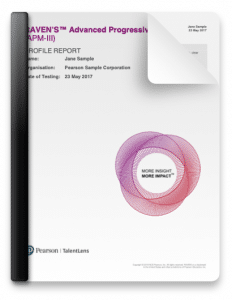
Source: Pearson TalentLens
FAQs
It’s a completely non-verbal exam of fluid reasoning—23 matrix puzzles that measure your ability to spot patterns and solve unfamiliar problems without relying on language or learned facts.
You’ll be tested on abstract thinking, pattern recognition, visual working-memory, mental rotation, and rapid concept acquisition under time pressure.
You face a 3×3 grid with one missing cell and eight answer choices. The exam splits into a 12-item easy set and an 11-item hard set, all delivered in a single 40-minute session.
Your raw correct-answer total (0–23) converts into age-adjusted percentiles, stanines (1–9), and often T-scores—giving you clear benchmarks against global peers.
No. Because it’s entirely visual and language-free, you don’t need vocabulary, math formulas, or test-specific content knowledge to succeed.
You get 40 minutes for all 23 items—about 90–100 seconds per puzzle—so your preparation should include strict timing drills.
Policies vary by provider. Many organizations allow a retake after a waiting period, but check with your test administrator for exact rules.
Hiring managers leverage your scores to predict learning agility, leadership potential, and on-the-job problem-solving; higher percentiles often open doors to advanced roles.
Focused practice by question type, timed full-length drills, and an error journal are your most effective tools—random question stacks won’t deliver the same targeted gains.
Yes. Standard accommodations (extended time, screen-reader compatibility, etc.) are typically offered—request them through your test provider well before your scheduled date.
Test Tips
- Arrive fully charged
Get a solid night’s sleep and eat a light, protein-rich meal. Fatigue or hunger will dull your pattern-spotting edge on Raven’s Advanced Progressive Matrices. - Bring only approved materials
Arrive with your ID, pencil, eraser, and scratch paper (or a charged device for computer delivery). No extra clutter—distractions cost precious seconds. - Skim the entire matrix set first
Spend 30 seconds scanning all 23 items to size up difficulty. Tackling a few easier puzzles at the start builds confidence and warms up your reasoning skills. - Identify question type immediately
The second you see a matrix, decide if it’s single-rule, dual-rule, overlay, XOR, or rotation. Locking in the correct pattern category saves wasted mental gymnastics. - Use process-of-elimination ruthlessly
Cross out any answer that breaks even one rule. In tight timing, you’re better off guessing from two choices than dithering over four. - Watch your pacing
If an item drags past 2 minutes, mark your best guess and move on. You can always revisit if time remains—but don’t let one puzzle steal your overall score. - Stay composed under pressure
When anxiety spikes, pause, take one deep breath, and refocus on the single transformation at hand. Clear-headed logic outperforms frantic guessing every time.
Administration
- Test Location
Available at authorized assessment centers worldwide or via secure online platforms. - Test Schedule
Book by appointment—year-round availability, subject to center hours or online slot openings. - Test Format
23 non-verbal, multiple-choice 3×3 matrices in one 40-minute session; delivered on paper or computer. - Test Materials
Centers supply the test booklets or digital interface; bring pencil, eraser, and scratch paper (or use on-screen tools). No calculators or external aids. - Cost
Fees vary by provider and format, generally ranging from about $30 up to $850 for materials and administration. - Retake Policy
Provider-dependent; most allow a retake after a specified waiting period—check with your test administrator for exact rules.
Test Provider
Raven’s Progressive Matrices was originally developed in the late 1930s by psychologist John C. Raven at the University of London as a pure measure of “eductive” or abstract reasoning. Today, the test is owned and published by Pearson Assessment (branded as Pearson TalentLens), with licensing partnerships—such as Hogan Assessments—extending its reach. With paper-and-pencil and fully digital delivery, Raven’s Advanced Progressive Matrices is available in over 15 languages and administered in more than 60 countries.
Pearson TalentLens offers the full Raven suite—Standard Progressive Matrices, Coloured Progressive Matrices, and Advanced Progressive Matrices (APM-III)—alongside scoring platforms, norm-referenced reporting, and integration tools for HR and educational settings. Hogan Assessments licenses APM-III within its leadership and talent-development solutions, providing robust online administration, customizable report dashboards, and secure proctoring options for global enterprise clients.
Information Sources
- Pearson TalentLens – https://www.talentlens.com
- Hogan Assessments – https://www.hoganassessments.com
Disclaimer – All the information and prep materials on iPREP are genuine and were created for tutoring purposes. iPREP is not affiliated with Pearson TalentLens, which is the owner of the Raven’s Progressive Matrices Test, or with any of the companies or organizations mentioned above.
Free Raven’s Progressive Matrices practice test: Get to know what the Raven’s Progressive Matrices (APM-III) will be like by practicing with these sample questions:
Question 1 of 14
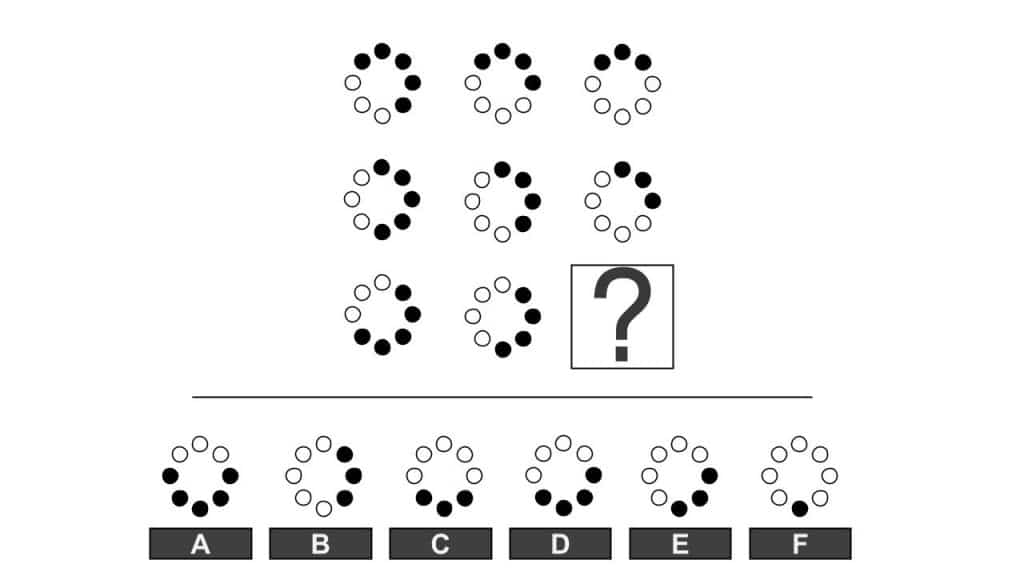
The correct answer is A.
Explanation:
To solve the matrix, follow the 2×2 Steps logic:
Start with Element 1, imagining it as a necklace with eight beads, one of them black.
1 Step to the right: Add another black bead opposite the first black bead. This pattern is seen in the middle column.
2 Steps to the right: Place two black beads on both sides of the bead added in Step 1, then turn the bead placed in Step 1 white. This pattern is seen in the right column.
Step 1 Down: Add two black beads on both sides of the original black bead, replacing white beads. This pattern is seen in the middle row.
Step 2 Down: Add two more black beads on both sides of the three black beads from Step 1, replacing white beads. This pattern is seen in the bottom row.
The missing element must follow both Step 1 & 2 Right and Step 1 & 2 Down. Unlike other elements, it should result in a series of black beads with only one white bead opposite the original black bead. Option A demonstrates this.
Question 2 of 14
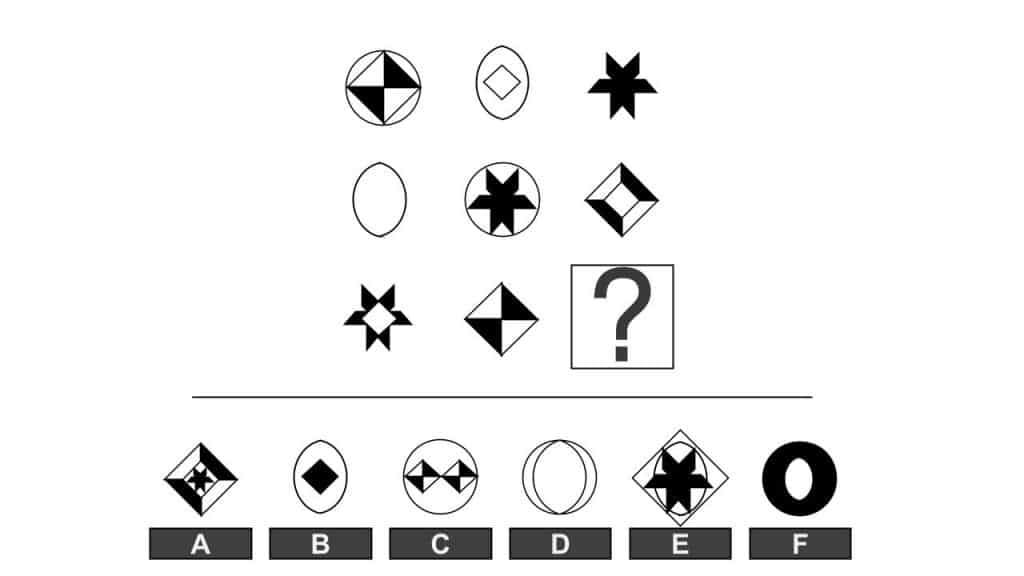
The correct answer is D.
Explanation:
To solve this matrix, focus on two logical rules:
#1 Basic shapes are determined by the 2-4-9 diagonal:
- Elements 1, 6, and 8 are a diamond with two black triangles and two white triangles.
- Elements 3, 5, and 7 are plain black figures.
- Elements 2 and 4 are white vertical ovals, suggesting the correct answer should also be a white oval. This leaves options B and D, as option E combines two basic figures.
#2 Special features are determined by the 1-5-9 diagonal:
- Elements 3, 4, and 8 lack additional features.
- Elements 2, 6, and 7 have a small white diamond partially covering them.
- Elements 1 and 5 are encircled by a simple circle. Thus, the missing element should also be encircled, matching option D – a vertical white oval encircled by a circle.
Tips & Tricks:
- At first glance, you could eliminate Option D because it resembles two moon shapes facing each other. However, after analyzing the matrix logic we know that it is actually an oval inside of a circle, and our correct answer.
- When faced with sets of three elements sharing a feature and two elements with a different realization, the correct answer often resembles the latter two. Use this to systematically eliminate options.
Question 3 of 14
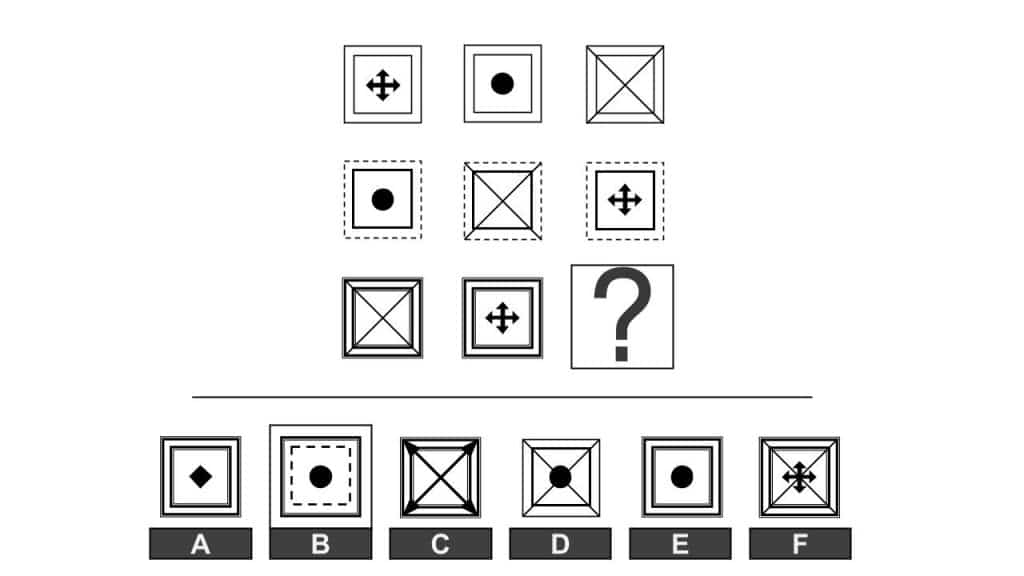
The correct answer is E.
Explanation:
To solve this matrix, consider the following:
Basic Concept:
- Each element is made of a frame and an additional feature.
- The matrix follows two logical rules: the frames are determined by row, and the additional features by diagonal.
Frames:
- Top row: solid black line for both outer and inner frames.
- Middle row: dashed outer frame, solid inner frame.
- Bottom row: compound thick lines for both frames.
Additional Features (Follows 2-4-9 diagonal):
- Elements 1, 6, 8: cross made of arrows.
- Elements 3, 5, 7: diagonals forming an X.
- Elements 2, 4, and the missing element 9: a black circle.
The missing element should have a black circle framed by two, compound, thick frames, matching option E.
Question 4 of 14
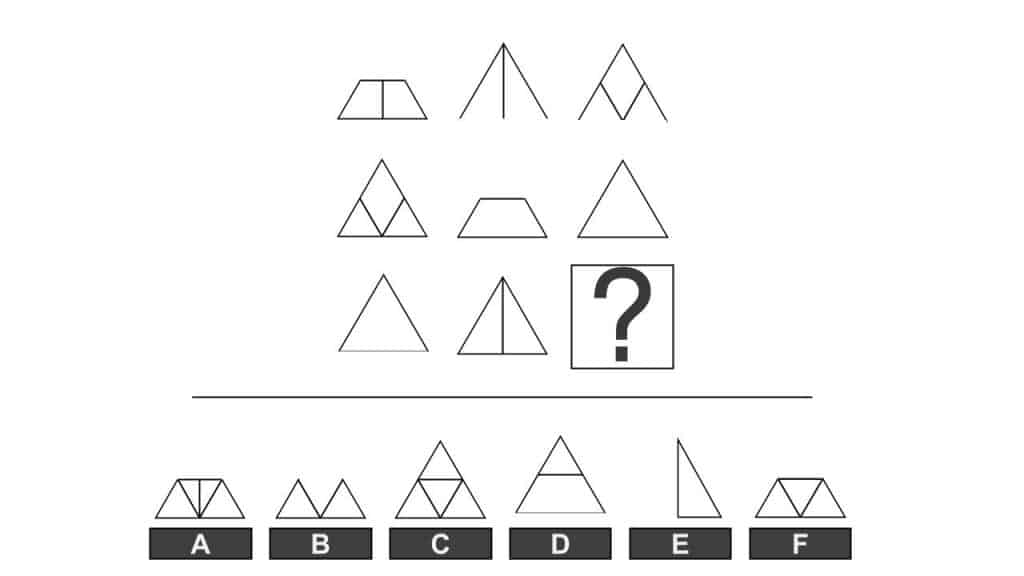
The correct answer is F.
Explanation:
Each element in the matrix is based on one of three basic triangles, with their features randomly distributed. Despite this complexity, the matrix follows two logical rules.
#1 Three basic triangles:
- Triangle 1: Simple triangle, seen in elements 5, 6, and 7 (Element 6 is the original).
- Triangle 2: Triangle with a perpendicular line, found in elements 1, 2, and 8 (Element 8 is the original).
- Triangle 3: Triangle with a V shape, seen in elements 3, 4, and the missing element (Element 4 is the original).
#2 Each triangle has three variations:
- Original form: No alterations, seen in elements 4, 6, and 8.
- Missing bottom edge: Seen in elements 2, 3, and 7.
- Missing top section, creating a trapezoid: Seen in elements 1, 5, and the missing element.
The correct answer is Option F, which matches the logic of Triangle 3, with the top section missing and forming a trapezoid. Options B and A can be eliminated early on due to missing or excessive lines.
Question 5 of 14
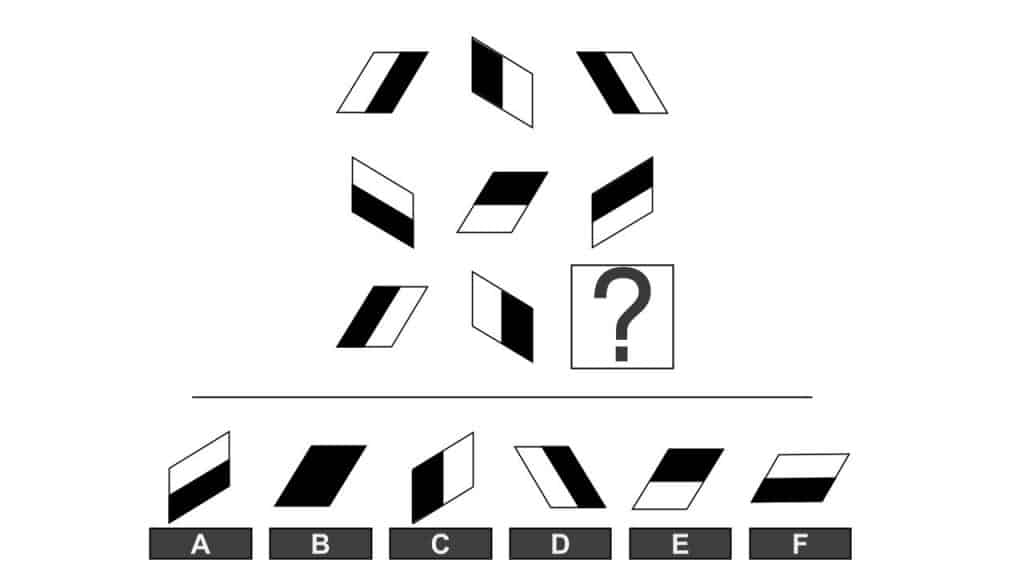
The correct answer is D.
Explanation:
To solve the matrix, focus on its column logic.Each column contains a different parallelogram. Moving from top to bottom, each parallelogram rotates 90 degrees clockwise. So, the missing element is element 6 rotated 90 degrees clockwise, as shown in option D.
Tips & Tricks:
Sometimes, intuition can help. For example, if you notice that the top and bottom elements of each column are similar except for color differences, you can rely on your intuition to answer the question. In this case, option D matches the top element of column 3, with colors reversed.
If you find similarities between elements in certain columns but struggle to explain them logically, focus on the patterns you do understand. In this case, if you can’t explain why left and right columns are similar, stick to the logic you’ve deciphered and choose accordingly.
Question 6 of 14
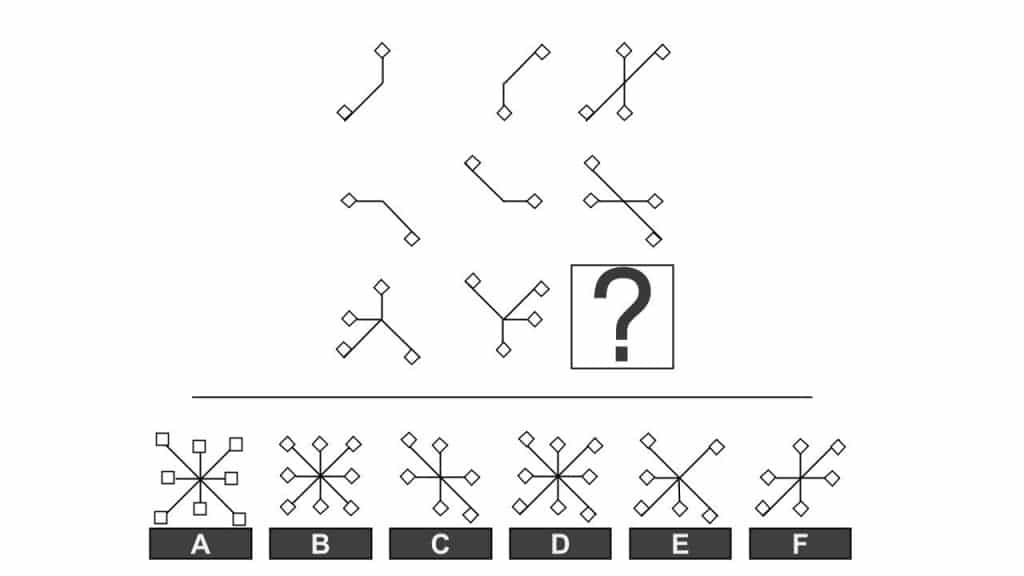
The correct answer is D.
Explanation:
The matrix operates on the four building block structure.
Elements 1, 2, 4, and 5 are the building blocks. The right column elements are a combination of the first two elements in the respective row.
Similarly, the bottom row elements are a combination of the first two elements in the respective column.
The missing element combines either elements 7 & 8 (bottom row) or elements 3 & 6 (right column). It’s a construct of 8 different pins, as shown in option D.
Question 7 of 14
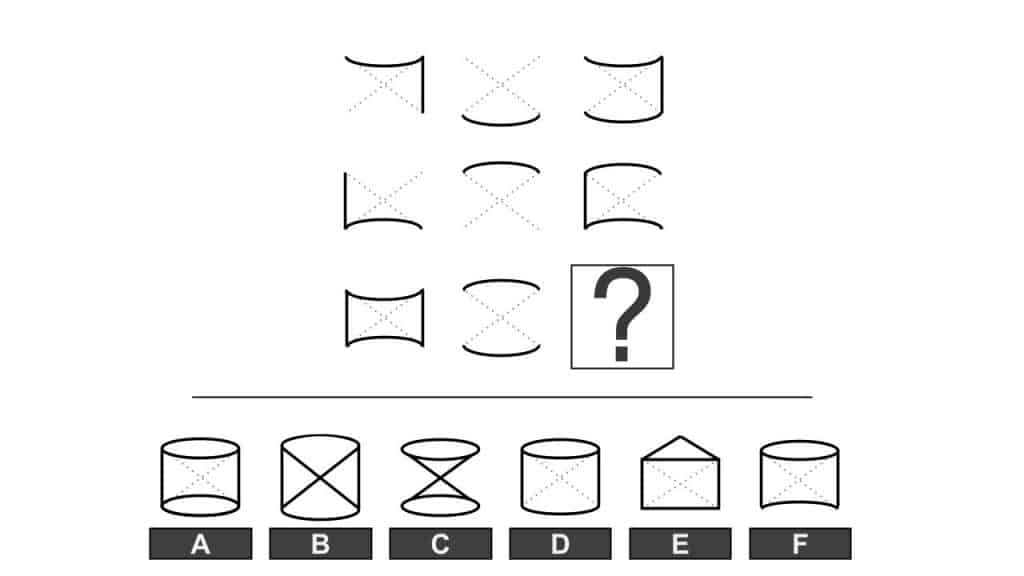
The correct answer is A.
Explanation:
This matrix follows the classic “4 building blocks” pattern, with elements 1, 2, 4, and 5 serving as our building blocks.
The elements in the right column are created by combining the elements in the first two columns. Similarly, the elements in the bottom row are formed by combining the elements in the first two rows.
To find the missing element, combine all four building blocks, or combine the elements of the right column or bottom row.
Tips & Tricks:
Diagonal lines (forming an X) are constant features used as a reference for the correct position of highlighted lines in the options.
Question 8 of 14
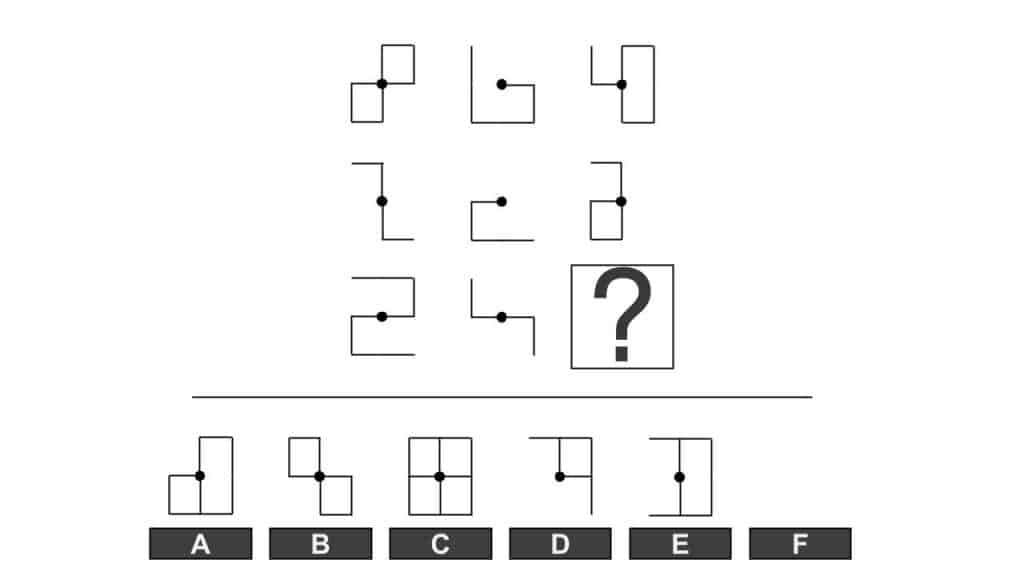
The correct answer is F.
Explanation:
To solve, understand the combined logic by rows and columns.
Compare any two elements of one row or column. If they share a feature, the third element of that column doesn’t include that feature. If a feature appears in only one of them, it’s included in the third element. The black dot in the middle serves as a spatial reference.
Looking at the images below – green lines appear in only one element of the row/column. Red lines appear in both elements and should not be in the correct answer. Once you understand the matrix logic, you can trace the correct answer by following either the bottom row or the right column.
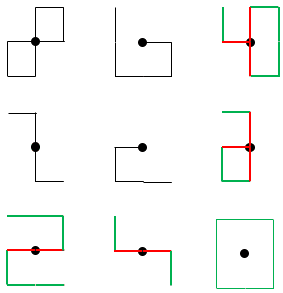
Question 9 of 14
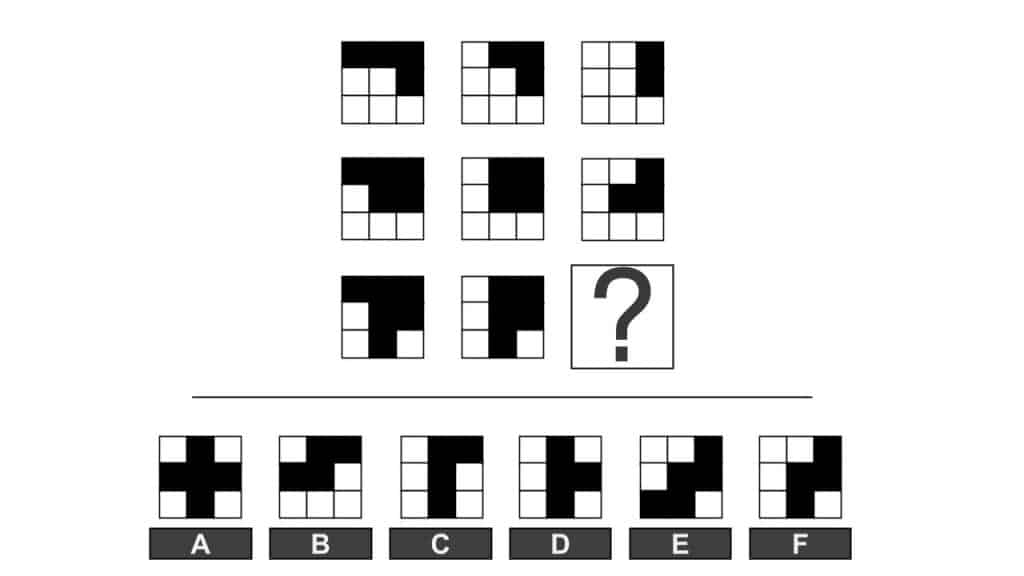
The correct answer is F.
Explanation:
This is a 2X2 Steps matrix.
Element 1 is the starting position – nine squares, four of them are black.
Let’s start by looking at the top row:
- 1 Step to the right – the top-left square becomes white. Notice that all the elements of the middle column comply with that.
- 2 Steps to the right – the middle square of the top row becomes white.
Now, let’s look at the first column:
- 1 Step down – the middle square becomes black. Notice that all the elements of the middle row comply with that.
- 2 Steps down – the middle square of the bottom row becomes black.
The missing element will follow 2 steps to the right and 2 steps down, which matches option F.
Tips & Tricks:
Once you realize what the steps are, you may be able to eliminate enough options even if you haven’t gone through all four “steps”. As soon as you have enough logic to eliminate all options but one, you can either mark it and move on to the next question or use the rest of the “steps” in order to check your answer.
Question 10 of 14
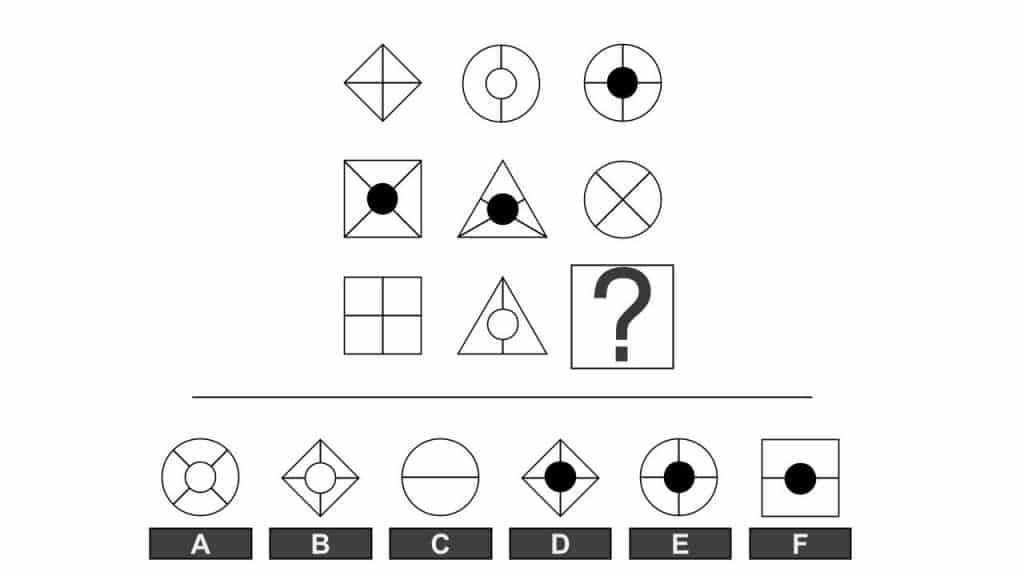
The correct answer is E.
Explanation:
This matrix can be solved using the logic of the columns.
Each element has a basic shape and internal features. In each column, the bottom element’s basic shape is determined by the middle element, and its internal shape is determined by the top element.
To find the missing element, look at the right column. The missing element should be a circle (based on the middle element), narrowing our options to A, C, and E. The missing element should also have a cross with a black circle (based on the top element), making option E our correct answer.
Tips & Tricks:
It is tempting to define the logic of this matrix using three groups of matching features. For example, three elements have an internal cross, three elements have an internal X, and only two elements have an internal vertical line. However, there are no answer options that have a single vertical line. While it is good to notice these patterns, if options don’t support them, rethink the matrix logic and offer an alternative assumption.
Question 11 of 14
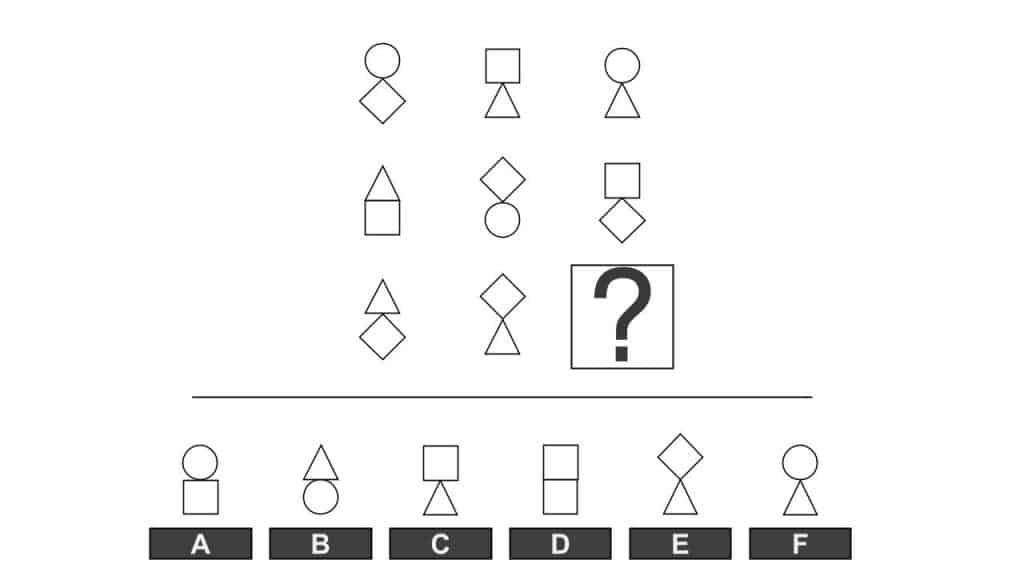
The correct answer is C.
Explanation:
This matrix can be solved by understanding the logic of the columns.
Each element is comprised of two shapes on top each other. The first two elements in each column are the building blocks to create the third element in the same column:
- The top shape of the middle element determines the top shape of the bottom element.
- The bottom shape of the top element determines the bottom shape of the bottom element
If we apply this logic to the right column, the missing element is comprised of the top shape of element 6 (a square) and the bottom shape of element 3 (a triangle) – which is exactly option C.
Question 12 of 14
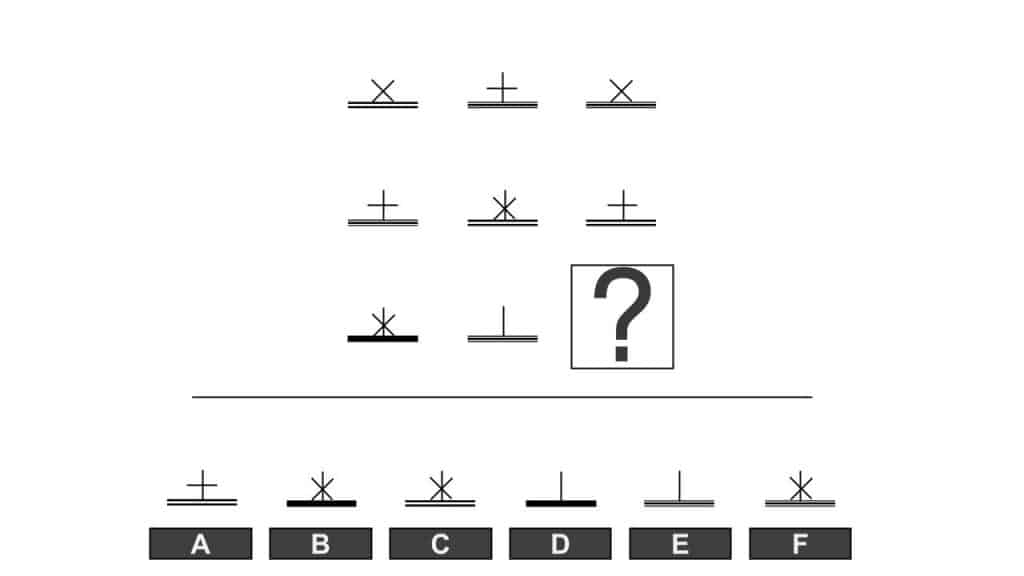
The correct answer is F.
Explanation:
The solution is found by understanding the matrix logic in rows.
Each element consists of a horizontal line and a shape above it. The left and middle columns serve as the building blocks to create the third column.
The horizontal line in the right column matches the middle element’s line in the same row. Similarly, the shape above the line in the right column matches the left element’s construct in the same row.
Based on these conclusions, the missing element in the bottom rows combines the middle element’s horizontal line (3 lines, the middle being thickest) with the left element’s shape (*) above the line from the. This matches option F precisely.
Question 13 of 14
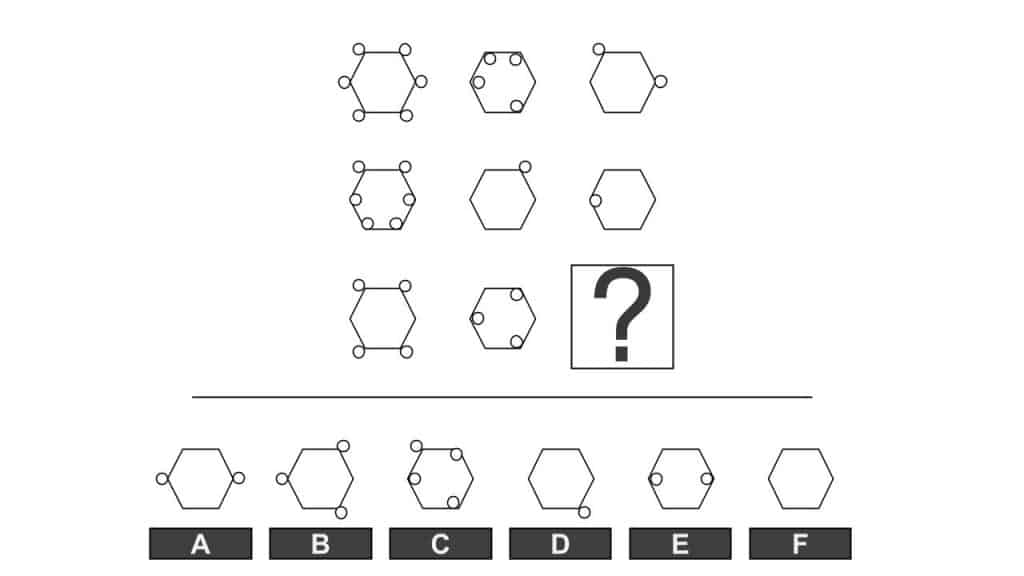
The correct answer is D.
Explanation:
This matrix is a modified “4 building blocks” matrix.
Each element comprises a hexagon and small circles. Elements 1, 2, 4, and 5 are the basic building blocks. The circles represent numbers: external circles count as 1, while internal circles count as (-1). For example, element 1 equals 6 (6 external circles); element 4 equals -2 (2 external and 4 internal circles).
The right column and bottom row result from basic arithmetic:
- By row: left element + middle element = right element.
- By column: top element + middle element = bottom element.
The missing element is the sum of all four building blocks and follows the same arithmetic logic: it’s the sum of either the other two elements of its columns (2-1) or the other two elements of its rows (4-3). In both cases, its value is 1, as in option D.
Tips & Tricks:
Aside from whether circles are placed inside or outside the hexagon, the circle positions are irrelevant for the solution; they serve as distractions.
Question 14 of 14
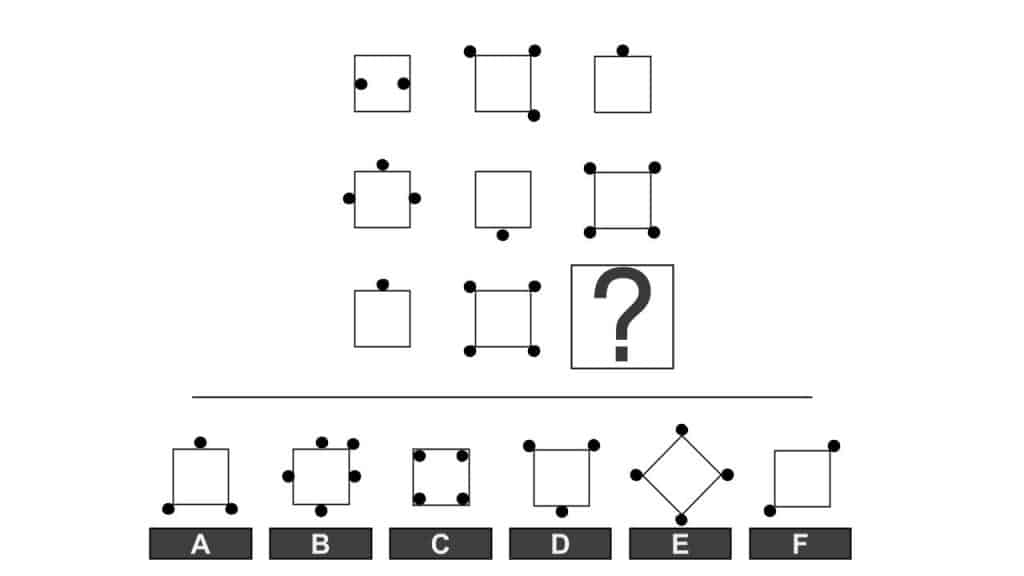
The correct answer is B.
Explanation:
This is a variation of the “4 building blocks” matrix.
Each element of the matrix is made of a square and a few black circles. Elements 1,2,4,5 are the four basic building blocks.
Circles outside the square each represent the number (1), while circles inside the square represent (-1). For example, both elements 2 and 4 equal three because they both have three black circles outside of the square. (Notice how the exact position of the circles doesn’t affect the value, it is merely a distracting feature.)
The elements of the right column and the elements of the bottom row are the result of following this formula:
- By row: left element + middle element = right element
- By column: top element + middle element = bottom element
The missing element is the combination of all four building blocks, the combination of elements in the bottom row, or the combination of elements in the right column. In all three cases, its value is five, like option B.
Curriculum
- Course Introduction
- Inductive & Abstract Reasoning Warm-Up
- The Basic Structure of The Matrix
- Matrix Problems Warm-Up
- Deciphering the Logic → Solving the Matrix
- Raven’s Advanced Matrices Test Simulations
- Course Conclusion
Reviews

Ian S*******
December 3, 2025 at 12:58 PM
I love this site, it explains things perfectly! The Ravens Progressive Matrices concept was new to me and I was concerned how challenged it appeared to be. I would not have been prepared for my test without it...

Tuk A***
November 25, 2025 at 7:03 AM
Very, very insightful course, explaining the logic behind the Matrices. Course gives one a sense of confidence when doing an assessment. Most helpful!

Ernest W******
November 15, 2025 at 9:01 PM
These matrices appeared as a total mystery to me, but with the excellent explanations provided in this course, they now make sense!

Lydia L***********
October 23, 2025 at 9:09 AM
This course was perfect for helping me prepare for the test. I haven't been in school for over 30 years so it helped me to focus on key strategies for taking the Raven test.

Anang S****
October 13, 2025 at 4:53 PM
Great structured practice which helps to ace the interviews and personality tests, made with explanations to work through, helping to get accustomed to this test quickly

Venkatachalam R*******
October 4, 2025 at 1:15 PM
Great resources and explanations. Very useful for anyone preparing for the exams. They are various types of challenges available. Must try

Jasmin R*****
September 29, 2025 at 4:48 AM
The reviewer is very effective and helpful. The video materials are clear and on point, while the practice tests reinforce learning. Truly a reliable tool for exam preparation and success.

Yasir D*****
September 13, 2025 at 8:44 AM
A truly excellent resource, made me work hard!! Explanations videos were super helpful and clear, and practice makes perfect! Very easy to use, thank you!

prashant k****
September 7, 2025 at 8:51 AM
great course,..really helped to ace the test..thank you iPrep. Just what i needed for preparation for my exam. So good!! passed my test with flying colors, they went above n beyond what was expected of me on my exam!!!

NIcolas P******
August 29, 2025 at 9:15 PM
I can't even begin to explain how valuable this program has been. I first looked at a matrix cold and had absolutely no clue, but now, after following the modules I'm up to ~70% score through 2 practice tests. I'm saving the last 2 for right before my formal exam. Don't know where I would have been without iPrep!